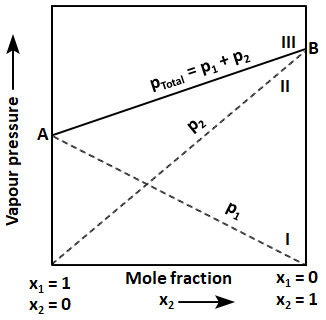Points A and B in the below-mentioned graph represent, respectively:
| 1. | Partial pressures of first and second components |
| 2. | Vapour pressures of the pure second and first components |
| 3. | Partial pressures of second and first components |
| 4. | Vapour pressures of the pure first and second components |
The mole fractions of each component, that is, CHCl3 and CH2Cl2 in vapour phase are respectively:
1 0.82; 0.18
2. 0.16; 0.84
3. 0.18; 0.82
4. 0.84; 0.16
The correct option for the value of vapour pressure of a solution at 45 C with benzene to octane in a molar ratio 3:2 is:
[At 45 C vapour pressure of benzene is 280 mm Hg and that of octane is 420 mm Hg. Assume Ideal gas]
| 1. | 336 mm of Hg | 2. | 350 mm of Hg |
| 3. | 160 mm of Hg | 4. | 168 mm of Hg |
The correct statement regarding a solution of two components A and B exhibiting positive deviation from ideal behaviour is :
| 1. | Intermolecular attractive force between A-A and B-B are stronger than those between A-B |
| 2. | ∆mixH = 0 at constant T and P |
| 3. | ∆mixV = 0 at constant T and P |
| 4. | Intermolecular attractive forces between A-A and B-B are equal to those between A-B |
1. Benzene + Toluene
2. Acetone + Chloroform
3. Chloroethane + Bromoethane
4. Ethanol + Acetone
For an ideal solution, the correct option is:
1. at constant T and P
2. at constant T and P
3. at constant T and P
4. at constant T and P
For a binary ideal liquid solution, the curve that represents the variation in total vapor pressure versus composition of the solution is:
| a. |  |
b. |  |
| c. |  |
d. |  |
The correct option is:
1. a and b
2. b and c
3. c and d
4. a and d
Select the correct option based on statements below:
| Assertion (A): | When methyl alcohol is added to water, boiling point of water increases. |
| Reason (R): | When a volatile solute is added to a volatile solvent, elevation in boiling point is observed. |
| 1. | Both (A) and (R) are True and (R) is the correct explanation of (A). |
| 2. | Both (A) and (R) are True but (R) is not the correct explanation of (A). |
| 3. | (A) is True but (R) is False. |
| 4. | Both (A) and (R) are False. |
The vapour pressure of water (in mm Hg) for this solution is :
| 1. | 23.40 | 2. | 0.23 |
| 3. | 12.87 | 4. | 40.14 |
On the basis of the information given below, mark the correct option.
| i. | In a bromoethane and chloroethane mixture, intermolecular interactions of A—A and B—B type are nearly the same as A—B type interactions. |
| ii. | In an ethanol and acetone mixture, A—A or B—B type intermolecular interactions are stronger than A—B type interactions. |
| iii. | In a chloroform and acetone mixture, A—A or B—B type intermolecular interactions are weaker than A—B type interactions. |
1. Solutions (ii) and (iii) will follow Raoult’s law
2. Solution (i) will follow Raoult’s law
3. Solution (ii) will show negative deviation from Raoult’s law
4. Solution (iii) will show positive deviation from Raoult’s law







